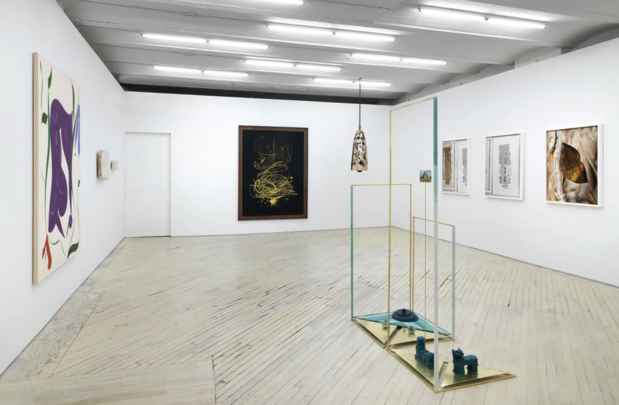“Throughline” Exhibition
Bureau

This event has ended.
Bureau presents a group exhibition presenting the work of six artists in various media. The image of a lone pay phone on a quiet and curving city street opens the show. Viola Yeşiltaç’s silver gelatin print, The Surveyor, captures a receiver-shaped phone cabin - an antiquated but universal symbol for the potential of communication and connection. A ring from another place - or perhaps another time - opens the line; a sound wave is the conduit into the show.
Thrumming the wires to reverberate, Yeşiltaç also presents a painting which shows buzzy lines of gold ink on the reverse of black faux-leather. The central illustration could be hovering on the surface of its substrate, or perhaps it is multi-dimensional, within an endless field of black space. The velvety surface supports an animated composition of interlocking geometric forms dotted with small symbols and notations in an almost calligraphic language, ecstatically layered and sketched onto a blackboard-like surface.
Patricia Treib’s works share this sense of gesture and movement of line, with script-like brushstrokes of oil, here presented on small works on paper and one large painting. At both scales, Treib offers a suite of works from a single original source image; each echoing with its siblings and revealing a long history of studied looking, all inscribed within Treib’s lush strokes. Nothing is fixed; every change of light modulates a color, every movement compels a change in scale and proportion. Treib plays with a mercurial subject, which could be seen as time itself, whose changing nature, as well as the observer’s own ungraspable constancy, remains illusory.
Nour Mobarak’s works support this embrace of the unstable nature of objects, presenting two works from her Mycelium Memory Paintings, which use the growth of saprophytic mycelium fungi to alter, and in essence, erase, the surface of her paintings. In an act of self-defacement, the artist lets go of the originally painted images, one a childhood memory of an encounter with a boy on the streets of 90s Beirut, another of a family gathering in an airport to cheer her father’s departure. The surface of the paintings cedes its pictorial, narrative space to one that instead demonstrates the effects of time passing. Mobarak both fossilizes and releases these image-memories, with a desire to explore the intangibility of the ever expiring past, and, in her own words, ‘give form to death and decomposition.’
Jeffrey Stuker’s work likewise investigates the illusory and unstable nature of representation. Stuker presents two pairs of images: one a study of an ancient fragment of papyrus containing lines from a lost Sophocles play, Inachus, the other depicting a butterfly, Kallima Inachus, that perfectly mimics dead oak leaves for its own protection from predators. While Stuker’s images are exactingly engrossing, these pictures are part of his most recent project which originated from an image that came to the artist in a dream. The work willingly follows lines stemming from the unconscious, or from worlds beyond our rational minds.
Claudia Peña Salinas mines stories of humanity’s ultimate dream: that of divine and mythological belief. Taking inspiration from pre-Columbian symbology and architecture, Salinas’s sculpture and painting here focus on the Mayan temple of Kukulcán (El Castillo) at Chichen Itza. For her sculptures she makes minimal frames out of thin brass dowels which she secures by wrapping with hand-dyed thread. At the base of this airy geometric structure sits statuettes of El Castillo’s related deities Chac Mool, the red Jaguar and Kukulcán, each painted with a blue pigment, sacred to the Maya. Her paintings also focus on the iconography and mathematical logic of the temple and its deities. El Castillo was designed to align with the celestial, and on the equinoxes two serpent figures of Kukulkán at the base of the pyramid appear to have their long tails running down the side of the pyramid. Grounded upon the earth and aligning with the heavens, the earthly viewer may experience and contemplate the throughlines of impermanent matter and the immaterial.
Davina Semo’s work tests the fixity of the material realm, working in cast bronze. The artist focuses on patinating and polishing the surfaces which reveal movement and flow to the otherwise permanent objects. Her wall piece Reach is a kind of shining, ornamental fossil, showing a motif of three bending flowers made by twisting, dragging, pressing and otherwise carving the composition using simple tools. The flowers might animate as the play of light dances on the surface. In all of Semo’s reflective surfaces the viewers and specific locality become part of the visual quality of the object itself. Similarly the hanging work Luster, suspended above the viewer, invites interaction both visually, and physically. The artist has focused for several years on the form of the bell, and here, Luster radiates with potential, as a vessel ready to sound and reverberate.
Media
Schedule
from January 14, 2023 to February 25, 2023